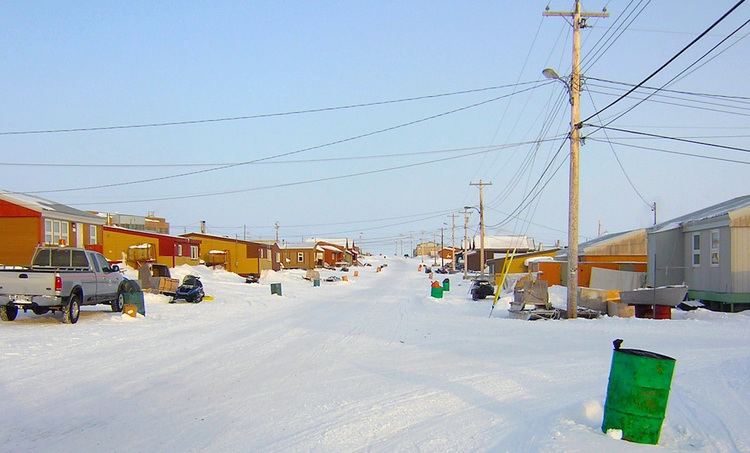Country Canada Time zone MST (UTC-7) Elevation 47 m Population 1,324 (2016) Area code 867 | Electoral district Gjoa Haven Canadian Postal code X0B 1J0 Area 28.47 km² Local time Tuesday 6:10 AM Number of airports 1 | |
 | ||
Weather -21°C, Wind SW at 31 km/h, 85% Humidity | ||
Gjoa Haven (/ˌdʒoʊ ˈheɪvən/; Inuktitut: Uqsuqtuuq, syllabics: ᐅᖅᓱᖅᑑᖅ, meaning "lots of fat", referring to the abundance of sea mammals in the nearby waters) is a hamlet in Nunavut, above the Arctic Circle, located in the Kitikmeot Region, 1,056 km (656 mi) northeast of Yellowknife, Northwest Territories. It is the only settlement on King William Island.
Contents
- Map of Gjoa Haven NU Canada
- Cyhk gjoa haven nunavut canadian arctic rwy31t approach landing cheyenne ii pa31t cockpit
- Etymology
- History
- Attractions
- Religion
- Government services
- Economy
- Education
- References
Map of Gjoa Haven, NU, Canada
Cyhk gjoa haven nunavut canadian arctic rwy31t approach landing cheyenne ii pa31t cockpit
Etymology
The name Gjoa Haven is from the Norwegian Gjøahavn or "Gjøa's Harbour"; it was named by early 20th-century polar explorer Roald Amundsen after his ship Gjøa. This was derived from the old Norse name Gyða, a compressed compound form of Guðfríðr (guð "god" and fríðr "beautiful"').
History
In 1903, the Norwegian explorer Roald Amundsen had entered the area on his ship Gjøa in an expedition intending to travel through the Northwest Passage. By October the straits through which he was travelling began to ice up. Amundsen put Gjøa into a natural harbour on the southeast coast of King William Island. He stayed there, in what Amundsen called "the finest little harbor in the world", for nearly two years. He and his crew spent much of that time with the local Netsilik Inuit, learning from them the skills to live off the land and travel efficiently in the Arctic environment. This knowledge proved to be vital for Amundsen's later successful exploration to the South Pole. He explored the Boothia Peninsula, searching for the exact location of the North Magnetic Pole.
Some Inuit people in Gjøa Haven with European ancestry have claimed to be descendants of Amundsen (or one of his six crew, whose names have not remained as well known). Accounts by members of the expedition told of their relations with Inuit women, and historians have speculated that Amundsen might also have taken a partner, although he wrote a warning against this. Specifically, half brothers Bob Konona and Paul Ikuallaq say that their father Luke Ikuallaq (b. 1904) told them on his deathbed that he was the son of Amundsen. Konona said that their father Ikuallaq was left out on the ice to die after his birth, as his European ancestry made him illegitimate to the Inuit, threatening their community. His Inuit grandparents saved him. In 2012, Y-DNA analysis, with the families' permission, showed that Ikuallaq (and his sons) was not a match to the direct male line of Amundsen. Not all descendants claiming European ancestry have been tested for a match to Amundsen, nor has there been a comparison of Ikuallaq's DNA to that of other European members of Amundsen's crew.
Permanent European-style settlement at Gjoa Haven started in 1927 with a Hudson's Bay Company trading outpost. In 1941 Henry Larsen reached the post from the west. The settlement has attracted the traditionally nomadic Inuit people as they have adapted a more settled lifestyle.
In 1961, the town's population was 110. By 2001, the population was 960 according to the Census, as the Inuit have moved from their traditional camps to be close to the healthcare and educational facilities available at Gjoa Haven. At the 2016 census, the population was 1,324, an increase of 3.5% from the 2011 census. The Population Centre of Gjoa Haven showed 1,197 people living in 0.78 km2 (0.30 sq mi), a decrease of 1.4% from 2011.
Gjoa Haven has expanded to such an extent that a newer subdivision has been developed near the airport at 68°37′56″N 095°52′04″W.
The community is served by the Gjoa Haven Airport and by annual supply sealift. The area is home to CAM-B, a North Warning System site.
Attractions
Quqshuun Ilihakvik Centre is a community heritage museum and cultural centre opened in 2013.
Religion
Two churches are located in the hamlet:
Government services
Local
Territorial
Economy
Most employment in Gjoa Haven is with government services; there are a few commercial employers:
Education
Gjoa Haven has two schools:
